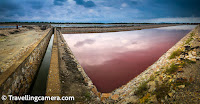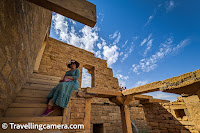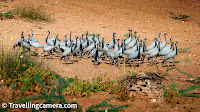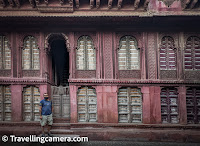 The Albert Hall Museum in Jaipur is also known as the Government Central Museum. This is the oldest existing museum of Rajasthan and a treasure trove of the state's cultural heritage. Situated in the heart of Jaipur, in the beautiful Ram Niwas Garden, this is indeed one stunning architectural marvel that attracts people all over the world. Built in Indo-Saracenic style, it is an epitome of art, history, and culture, comprising an enormous collection of artefacts that narrate epics of glorious India.
The Albert Hall Museum in Jaipur is also known as the Government Central Museum. This is the oldest existing museum of Rajasthan and a treasure trove of the state's cultural heritage. Situated in the heart of Jaipur, in the beautiful Ram Niwas Garden, this is indeed one stunning architectural marvel that attracts people all over the world. Built in Indo-Saracenic style, it is an epitome of art, history, and culture, comprising an enormous collection of artefacts that narrate epics of glorious India.
Historical Background:
 It was during the visit of Prince Albert of the United Kingdom in 1876 that the foundation stone of Albert Hall Museum was laid. What was started as the designing of a town hall for the city eventually took the shape of a museum because of the sophisticated architecture it would house the rich artistic heritage of Rajasthan. The founder of this place is Maharaja Sawai Ram Singh II of Jaipur, and it was inaugurated to the public by Maharaja Madho Singh II in 1887. However, this great project Albert Hall Museum owes its name to Prince Albert. It stands as a symbol of Jaipur's commitment to its cultural heritage.
It was during the visit of Prince Albert of the United Kingdom in 1876 that the foundation stone of Albert Hall Museum was laid. What was started as the designing of a town hall for the city eventually took the shape of a museum because of the sophisticated architecture it would house the rich artistic heritage of Rajasthan. The founder of this place is Maharaja Sawai Ram Singh II of Jaipur, and it was inaugurated to the public by Maharaja Madho Singh II in 1887. However, this great project Albert Hall Museum owes its name to Prince Albert. It stands as a symbol of Jaipur's commitment to its cultural heritage.
Architectural Beauty
 Indo-Saracenic architecture is a marvelous amalgamation of styles characteristic of Islamic and Rajput impressions infused with Gothic style, and therefore, the Albert Hall Museum is a fine example. Inspired by the Victoria and Albert Museum in London, it was conceptualized by Sir Samuel Swinton Jacob, one of the influential British architects of the time, who made this edifice stand distinct with the use of stone carvings, arched domes, and elaborate designs.
Indo-Saracenic architecture is a marvelous amalgamation of styles characteristic of Islamic and Rajput impressions infused with Gothic style, and therefore, the Albert Hall Museum is a fine example. Inspired by the Victoria and Albert Museum in London, it was conceptualized by Sir Samuel Swinton Jacob, one of the influential British architects of the time, who made this edifice stand distinct with the use of stone carvings, arched domes, and elaborate designs.
Major Architectural Features:
Façade: The museum façade has well-embellished jharokhas, chhatris, and latticework in intricate details to describe the beautiful ornamentation of Rajputana architecture.
Centre Dome: The main dome is the hallmark feature of this structure. The smaller domes and minarets adorn the main dome and are nothing but grand. The design is symmetrical, and the sandstone combined with marble adds a level of grandeur.
Marbles and Gardens: Marble fountains adorn the well-manicured gardens and paths of this museum. One can appreciate the beauty of these fountains to add aesthetic value to the site.
Collections and Exhibitions
The Albert Hall Museum contains a wide range of artifacts, artworks, and historical items that give insight into Rajasthan's rich cultural heritage. Exhibitions are distributed into various galleries under a different theme or era.
Some notable exhibitions include:
Sculptures and Statues: A beautiful collection of sculptures in marble, stone, and metal sculpted during ancient to the medieval period is present. In many of these sculptures, images are related to Hindu deities, Jain tirthankaras, and mythological figures that relate to religious and cultural beliefs of that period.
It has an extensive collection of miniature paintings from different Indian art schools-the Rajput, Mughal, Pahari, and Persian styles. These paintings contain scenes from Indian epics, court life, festivals, and nature.
Ancient Manuscripts: This museum showcases the very attractive collection of ancient manuscripts written on palm leaves and paper, unveiling the science, art, religion, and literature of those bygone eras.
Arms and Armor: There is a special gallery on Rajput arms where one can view swords, shields, knives, spears, and firearms in a beautiful array. Most of these are beautifully etched and encrusted with precious and semi-precious stones, representing the martial tradition of Rajasthan.
The museum also has some exquisite collections of traditional Rajasthani jewelry and costumes that typify the richness of the craftsmanship in the region. The collections also include royal garments, sarees, turbans, and even the traditional attire worn by the locals.
Among the wide variety of exhibits in the Albert Hall Museum, an Egyptian mummy from 322–30 BC is one of the most remarkable. In a room by itself, this rare artifact not only draws history buffs but curios who are not so interested but have heard about the burial practices of ancient Egyptian culture.
The museum owns a superb collection of ceramics and pottery among which many have the famous Blue Pottery of Jaipur so aptly popularly known for bright colors with intricate design. Such terra cotta works, porcelain, and earthenware abound in this gallery across parts of India.
Cultural Events and Activities
The Albert Hall Museum is not only for static exhibitions but is also meant to be a place for various cultural events and activities. It holds displays of art work, cultural performances, workshops, and heritage walks that keep the visitors occupied amidst the exciting and vibrant culture of Rajasthan. The museum glows during the night with colorful lights that are simply enchanting and add up to its history.
Cultural Importance
The film historians and heritage enthusiasts have often featured the museum in their movies, documentaries, and travel shows related to the history and heritage of Rajasthan. The place is apt for photographers and filmmakers due to its aesthetic beauty in architecture and its historic importance.
How to Reach
Address: The Albert Hall Museum can be reached as it is located in Ram Niwas Garden in the heart of Jaipur city.
Opening time: 9.00 AM to 5.00 PM during the day and sometimes at nights on special occasions.
Charge for visit: Indian citizens have separate ticket fee structures than foreign nationals, in addition to this certain camera fees and sun set visits. Best time to visit: Cool and amiable climate October to March Timings: The museum is open to tourists from 9.00 AM to 5.00 PM in the day and also sometimes to special night illumination.
During a visit to the Albert Hall Museum in the city, you can walk to other Jaipur attractions:
Hawa Mahal: It is a stunningly beautiful palace which has an utterly strange five-story façade with extremely minute carvings on windows.
City Palace: This majestic palace complex is the heart of Jaipur, and this is a mix of Mughal and Rajasthani architecture.
Jantar Mantar: The astronomical observatory built in the 18th century that is recognized as a UNESCO World Heritage site.
Albert Hall is much more than an art and artifact collection. It is alive testimony to the rich cultural heritage and history of Rajasthan. Diverse in its exhibits, the architectural beauty of this museum, and a wide variety of cultural events make it a destination to visit for anyone who would like to explore India's artistic and historical heritage. Whether one is an aficionado of history, art, or a traveler seeking to gain a better understanding of Rajasthan's past, Albert Hall Museum is one sure promise for this rich and unforgettable experience.
Related Blogposts:
 Amber Fort in Rajasthan : The Pearl of Jaipur's Rajput Architecture
Amber Fort in Rajasthan : The Pearl of Jaipur's Rajput Architecture
 Chand Baori in Abhaneri: A Marvel of Ancient Indian Architecture in Rajasthan
Chand Baori in Abhaneri: A Marvel of Ancient Indian Architecture in Rajasthan
 Bhandarej Baori: An Ancient Stepwell of Rajasthan's Heritage
Bhandarej Baori: An Ancient Stepwell of Rajasthan's Heritage
.jpg) Tour de Churu Streets having grand havelis with marvelous fresco paintings | Haveli Heritage Tour Rajasthan, India
Tour de Churu Streets having grand havelis with marvelous fresco paintings | Haveli Heritage Tour Rajasthan, India
 Beautiful Vyas Chhatris in Jaisalmer, Rajasthan || the most unusual sunset point built in a cremation ground
Beautiful Vyas Chhatris in Jaisalmer, Rajasthan || the most unusual sunset point built in a cremation ground
 Magnificent Cenotaphs at the Bada Bagh, Jaisalmer, Rajasthan || Exorbitant Ticket Prices can be a deterrent to anyone visiting the place
Magnificent Cenotaphs at the Bada Bagh, Jaisalmer, Rajasthan || Exorbitant Ticket Prices can be a deterrent to anyone visiting the place
 An interesting drive from Kuldhara to Khaba Fort, Dedha, Jaisalmer, Rajasthan || The Journey was definitely worth the visit to this beautiful little fort
An interesting drive from Kuldhara to Khaba Fort, Dedha, Jaisalmer, Rajasthan || The Journey was definitely worth the visit to this beautiful little fort
 A half day detour to Sambhar Salt Lake, Rajasthan from NH48 || What makes India's Largest Inland Salt Lake worth visiting in winters?
A half day detour to Sambhar Salt Lake, Rajasthan from NH48 || What makes India's Largest Inland Salt Lake worth visiting in winters?
 A fulfilling stop at Mandore in Jodhpur, Rajasthan || The old seat of the Rathore clan and also the birthplace of Mandodari
A fulfilling stop at Mandore in Jodhpur, Rajasthan || The old seat of the Rathore clan and also the birthplace of Mandodari
 The Golden Fort of Jaisalmer, Rajasthan || A thriving, pulsating mini city within the walls of the fort
The Golden Fort of Jaisalmer, Rajasthan || A thriving, pulsating mini city within the walls of the fort
 The splendid architecture of Patwon ki Haveli in Jaisalmer, Rajasthan || One of the most opulent of the havelis in Jaisalmer
The splendid architecture of Patwon ki Haveli in Jaisalmer, Rajasthan || One of the most opulent of the havelis in Jaisalmer
 The Abandoned Village of Kuldhara near Jaisalmer, Rajasthan || Facts and Fables about why the Paliwal Brahmins abandoned this village of their ancestors
The Abandoned Village of Kuldhara near Jaisalmer, Rajasthan || Facts and Fables about why the Paliwal Brahmins abandoned this village of their ancestors
 The Amazing Pokaran Fort near Jaisalmer, Rajasthan || A beautiful structure that effortlessly blends with the desert landscape it is built in
The Amazing Pokaran Fort near Jaisalmer, Rajasthan || A beautiful structure that effortlessly blends with the desert landscape it is built in
 Vedi Temple inside KumbalGarh Fort, Rajasthan - 3 Storey Octagonal structure standing strong on 36 pillars around world's second largest wall
Vedi Temple inside KumbalGarh Fort, Rajasthan - 3 Storey Octagonal structure standing strong on 36 pillars around world's second largest wall






























.jpg)
















.jpg)

.jpg)
Comments